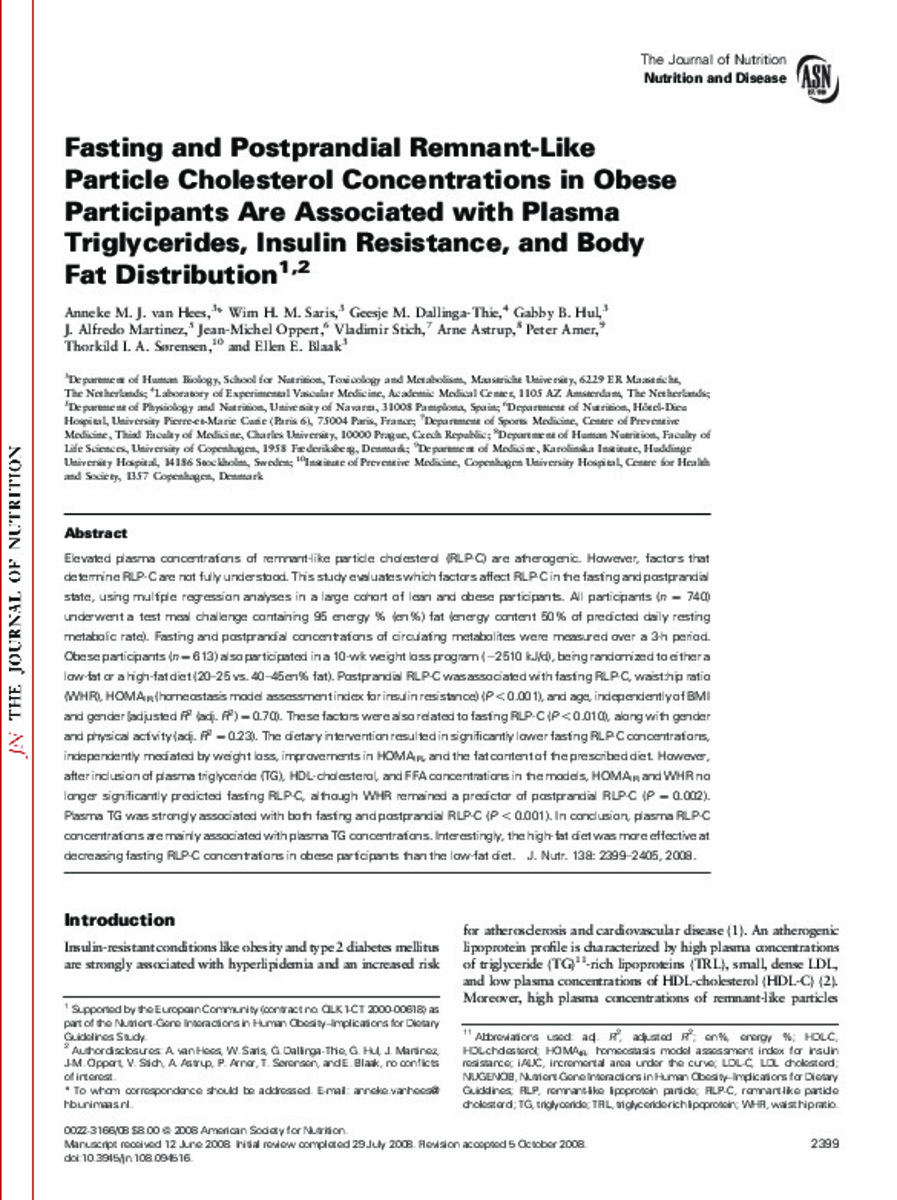Full metadata record
| DC Field | Value | Language |
|---|---|---|
| dc.creator | Van-Hees, A.M.J. (Anneke M.J.) | - |
| dc.creator | Saris, W.H.M. (Wim H. M.) | - |
| dc.creator | Dallinga-Thie, G.M. (Geesje M.) | - |
| dc.creator | Hul, G.B. (Gabby B.) | - |
| dc.creator | Martinez, J.A. (José Alfredo) | - |
| dc.creator | Oppert, J.M. (Jean M.) | - |
| dc.creator | Astrup, A. (Arne) | - |
| dc.creator | Arner, P. (P.) | - |
| dc.creator | Sørensen, T.I.A (Thorkild I. A.) | - |
| dc.creator | Blaak, E.E. (Ellen E.) | - |
| dc.date.accessioned | 2013-04-06T17:53:44Z | - |
| dc.date.available | 2013-04-06T17:53:44Z | - |
| dc.date.issued | 2008 | - |
| dc.identifier.citation | van Hees AM, Saris WH, Dallinga-Thie GM, Hul GB, Martinez JA, Oppert JM, et al. Fasting and postprandial remnant-like particle cholesterol concentrations in obese participants are associated with plasma triglycerides, insulin resistance, and body fat distribution. J Nutr 2008 Dec;138(12):2399-2405 | es_ES |
| dc.identifier.issn | 0022-3166 | - |
| dc.identifier.uri | https://hdl.handle.net/10171/28211 | - |
| dc.description.abstract | Elevated plasma concentrations of remnant-like particle cholesterol (RLP-C) are atherogenic. However, factors that determine RLP-C are not fully understood. This study evaluates which factors affect RLP-C in the fasting and postprandial state, using multiple regression analyses in a large cohort of lean and obese participants. All participants (n = 740) underwent a test meal challenge containing 95 energy % (en%) fat (energy content 50% of predicted daily resting metabolic rate). Fasting and postprandial concentrations of circulating metabolites were measured over a 3-h period. Obese participants (n = 613) also participated in a 10-wk weight loss program (-2510 kJ/d), being randomized to either a low-fat or a high-fat diet (20-25 vs. 40-45en% fat). Postprandial RLP-C was associated with fasting RLP-C, waist:hip ratio (WHR), HOMA(IR) (homeostasis model assessment index for insulin resistance) (P < 0.001), and age, independently of BMI and gender [adjusted R(2) (adj. R(2)) = 0.70). These factors were also related to fasting RLP-C (P < 0.010), along with gender and physical activity (adj. R(2) = 0.23). The dietary intervention resulted in significantly lower fasting RLP-C concentrations, independently mediated by weight loss, improvements in HOMA(IR), and the fat content of the prescribed diet. However, after inclusion of plasma triglyceride (TG), HDL-cholesterol, and FFA concentrations in the models, HOMA(IR) and WHR no longer significantly predicted fasting RLP-C, although WHR remained a predictor of postprandial RLP-C (P = 0.002). Plasma TG was strongly associated with both fasting and postprandial RLP-C (P < 0.001). In conclusion, plasma RLP-C concentrations are mainly associated with plasma TG concentrations. Interestingly, the high-fat diet was more effective at decreasing fasting RLP-C concentrations in obese participants than the low-fat diet. | es_ES |
| dc.language.iso | eng | es_ES |
| dc.publisher | American Society for Nutrition | es_ES |
| dc.rights | info:eu-repo/semantics/openAccess | es_ES |
| dc.subject | Cholesterol blood | es_ES |
| dc.subject | Lipoproteins blood | es_ES |
| dc.subject | Obesity blood | es_ES |
| dc.subject | Triglycerides blood | es_ES |
| dc.title | Fasting and postprandial remnant-like particle cholesterol concentrations in obese participants are associated with plasma triglycerides, insulin resistance, and body fat distribution | es_ES |
| dc.type | info:eu-repo/semantics/article | es_ES |
| dc.type.driver | info:eu-repo/semantics/article | es_ES |
| dc.identifier.doi | http://dx.doi.org/10.3945/jn.108.094516 | es_ES |
Files in This Item:
Statistics and impact
Items in Dadun are protected by copyright, with all rights reserved, unless otherwise indicated.






